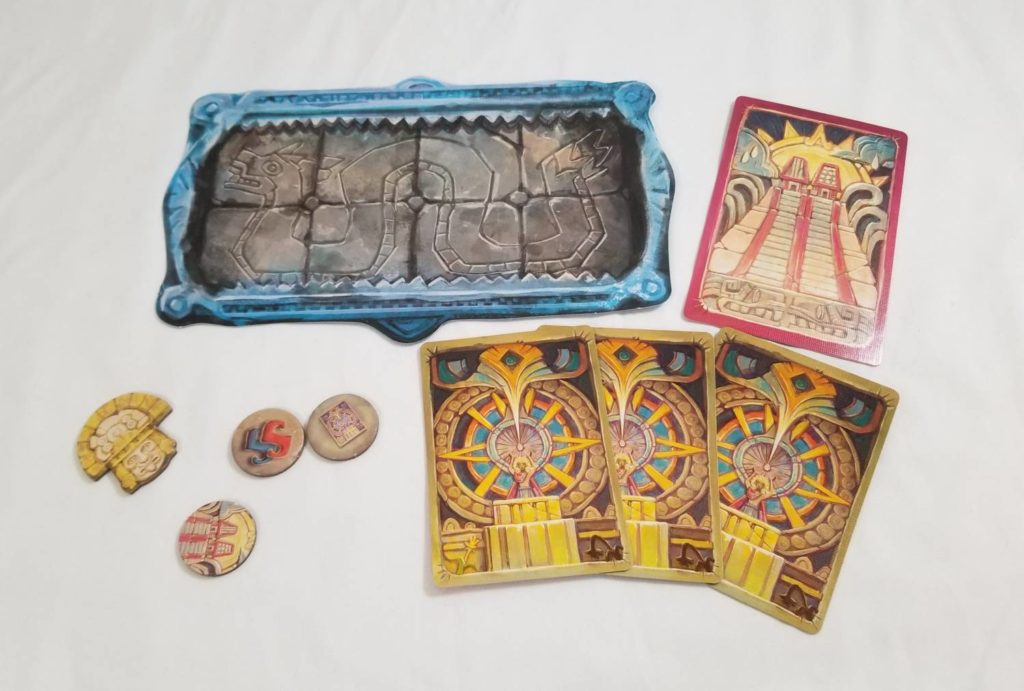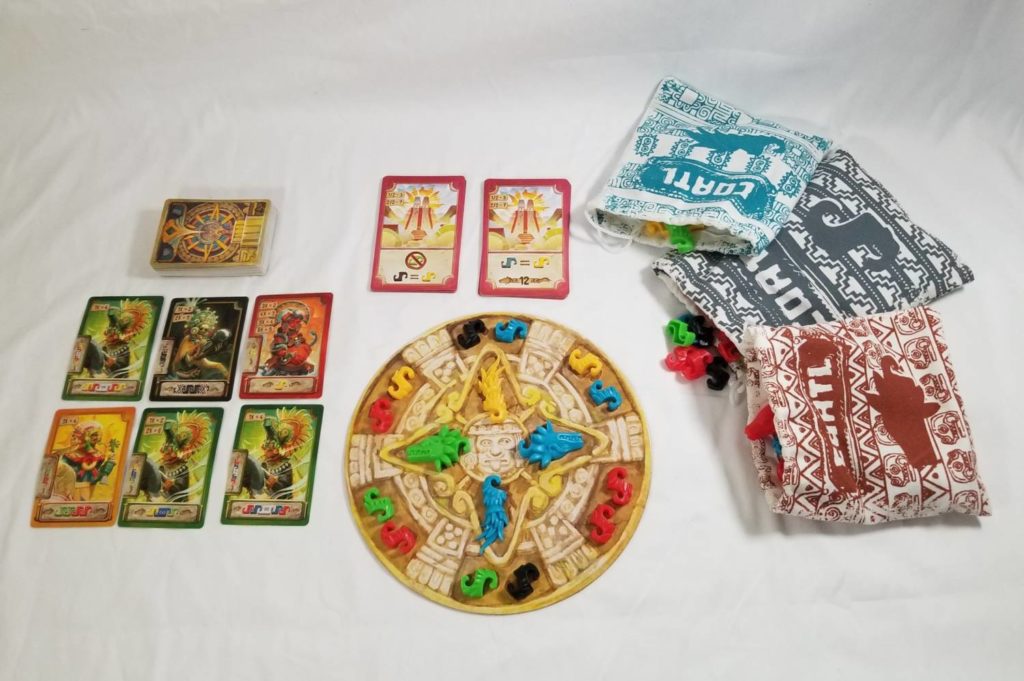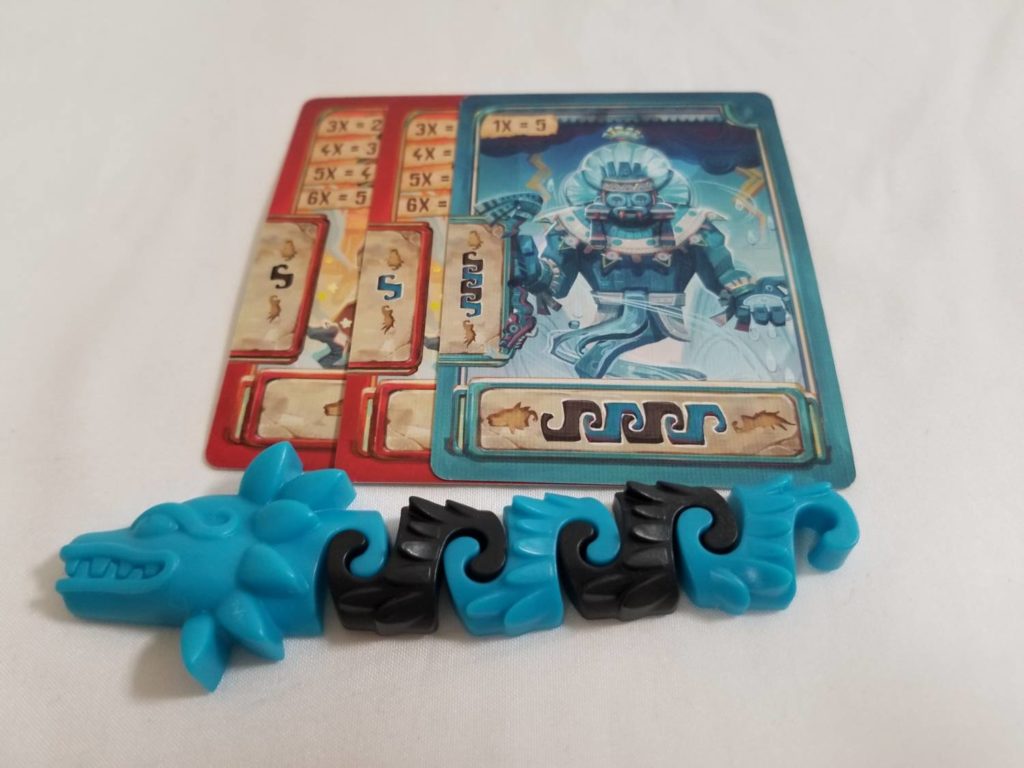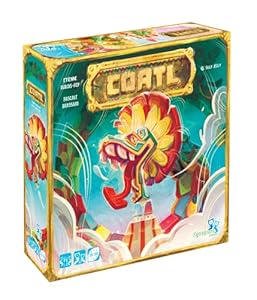Disclosure: Meeple Mountain received a free copy of this product in exchange for an honest, unbiased review. This review is not intended to be an endorsement.
In Cóatl—deriving its name from the feathered-serpent of Aztec mythology—the players take on the roles of sculptors vying for the favor of the gods in their bid to become High Priest. Using the brightly colored plastic components in conjunction with the cards in their hands, the players are competing to build the highest scoring cóatls possible.
Overview
On their turns, players choose from taking pieces from a central display into their supply, adding scoring cards to their hands from the Prophecy card deck, and adding to/creating brand new cóatls and/or assigning scoring cards to them. The plastic pieces are divided into three different types: heads, tails, and body segments. The Prophecy cards score for having specific colors and/or patterns of pieces within the cóatl they are assigned to. There are also Temple cards which are public objectives. When a player completes a cóatl (it has both a head and a tail), they may optionally assign one of the available Temple cards to it, to score bonus points, if the cóatl meets the criteria on the card.
The game ends when a player completes their third cóatl. Points are tallied up at the end of the game and the player who has the most wins.
Of course, this is a very high-level overview of the game. If you’ve heard enough and just want to know what I think, feel free to skip ahead to the Thoughts section. Otherwise, read on as we learn how to play Cóatl.
The Things You’ll See
A game of Cóatl is set up thusly:

Shuffle the Prophecy cards and place them face down in a deck. Repeat this for the Temple cards. Each player chooses a color and receives the playmat and Sacrifice tokens of their chosen color, a few Prophecy cards, and a Temple card. Their cards are kept hidden from the other players. They must keep their Temple card, but they will have the opportunity to discard some of their Prophecy cards if they desire. This is important as there’s a hand limit of five Prophecy cards and players may want to make room in their hands for more useful cards later on.
After getting the players squared away, the Prophecy card deck is set aside and six cards are drawn and placed face up next to it to form a supply. The Temple card deck is divided into two stacks and these are placed face up next to each other. Next, place the Supply board into the center of the table and populate it with components from the drawstring bags.

Finally, determine who the start player will be, give them the Start player token, and you’re ready to begin.
The Things You’ll Do
A game of Cóatl comes to an end once one person has built a total of three cóatl. No player may ever have more than two cóatl under construction at any given time. During your turn, you’ll be choosing from one of three actions—or ignoring them entirely to cash in one of your Sacrifice tokens to perform its action. There are three options: choosing body parts; choosing cards; or adding body parts.
Choosing body parts is as easy as picking a group of body parts from the edge of the board, or a head or tail from the center, and then adding them to empty storage bays on your player board, of which there are eight in total. If you can’t accommodate everything you take, you can’t take it. If taking body parts causes the locations along the edge of the board to become empty, they are replaced with body parts drawn from the requisite bag. The center gets refilled whenever it is emptied of heads and tails.
When choosing cards, you may draw cards from the Prophecy card display or draw blindly from the top of the Prophecy card deck up to a maximum of five cards in hand. The display does not refill until after you’ve ended your turn.
The third option, adding body parts, is the meat of the game. To begin a cóatl, simply place a piece from your Supply board onto the table in front of you. You may then add as many pieces as you wish to this cóatl, or even form a new one. The pieces you add and where you add them are largely going to be dictated by your Prophecy cards and the visible Temple cards.
Each Prophecy card, as mentioned earlier, scores for having a certain color or sequence of colors visible in your cóatl. Some cards may score for having multiples of the same color. Some look for specific sequences in the middle or on the ends. If you’ve added pieces to a cóatl and what you have in front of you could satisfy the Prophecy card’s requirements, then you can assign that card to that cóatl. Once assigned, though, it can never be moved.

Once you’ve slapped both a head and a tail to your cóatl, it is considered complete. You can only keep four of the Prophecy cards you’ve assigned to it. The others are discarded. And then you can assign a Temple card to it if at least one of the two criteria on the card are met. For instance, a Temple card might tell you that it scores three points if there are no yellow pieces in the cóatl OR an equal number of black and green pieces. But, if you’ve met both criteria—an equal number of black and green pieces and no yellow pieces—then you’ll score seven points instead.
Sacrifice tokens come in three flavors: claim a Temple card from the lineup for yourself and add it to your hand; go into one of the bags and pull out exactly the piece you need; or discard all the face up Prophecy cards and then refill your hand, up to your hand limit, using the new display of cards. Used wisely, these are very powerful abilities to have at your disposal, but their power is balanced by having to give up your entire turn to use them.
The Points You’ll Score
At the end of the game, players tally up the points earned from each of their cóatl (Prophecy cards plus Temple cards) and then compare totals. The player with the most points wins. Ties are broken in favor of the player who’s assigned the most cards.
To simplify final scoring, there is a score track printed on the back of the Supply board. Oddly enough, there aren’t any player-specific score tracker pieces provided. What my group usually does is give each person a body segment matching their player color and then use that as the score tracker.
Thoughts
The moment I first laid eyes on Cóatl, I knew I wanted to play it. This is a game with great visual appeal. The artwork is fantastic, and there’s just something undeniable about the allure of the brightly colored, plastic cóatl pieces. If you’ve ever played Ticket to Ride and held those plastic trains in your hands, then you’ve got a good idea of the quality and weight of the pieces in play here. There’s a great degree of similarity, but the pieces in Cóatl, especially the heads and tails, are larger in size and scope. If you haven’t played Ticket to Ride, a.) you should and b.) you’re just going to have to trust me when I tell you that these pieces feel great in your hands.
But a game is more than the sum of its constituent parts. As I raised my hand and volunteered to take on Cóatl, I knew that it looked great. What I didn’t know was whether or not there was actually a good game beneath the shiny veneer. So, when it finally arrived, I was eager to get it to the table to find out.
Like meeting a punk rocker who turns out to be a theoretical physicist, Cóatl defies all expectations. Its rustic charm and easy rule set belie its true nature. Cóatl is a beast.
At first, your choices are largely influenced by the cards you were initially dealt. If you’re lucky, two or three of them will have some overlap with each other. Or, at the very least, maybe one or two of them will overlap with the public offerings. If you’re even luckier, the demands of the cards will line up with the pieces available on the Supply board. Oftentimes, though, nothing lines up and you’re challenged right out of the gate with having to make lemonade out of some very rotten lemons.
A few rounds later, you’re building some steam. You’ve gotten a cóatl or two started and assigned a few Prophecy cards, and your opponent has done the same. The game is afoot! Things are chugging along nicely. And then you realize that Prophecy cards are public information and, without even meaning to, each player has unwittingly revealed their strategy.
This is when Cóatl reveals its fangs.

As if trying to construct a cóatl able to satisfy the cards you’ve assigned to it, and possibly one of the Temple cards, wasn’t hard enough, now you’ve got to consider what your opponents are going for. Can you deny them the pieces they need while also turning that denial to your advantage?
And when the pieces on the Supply board are getting low, it becomes a test of wills to see who is going to trigger the reset. I liken this to the tension that arises during a game of Jaipur when most of the market row is nothing but camels. Clearing the current options that nobody wants is going to replace them with options that people do want. And nobody wants that.
Needless to say, I was surprised at how quickly this serene game of cóatl creation turned into one of cutthroat confrontation. The shift was subtle and I didn’t mind it at all. In fact, I quite liked it. To paraphrase the great Nigel Tufnel, it turned it up to 11. Cóatl went from being pretty good to pretty great in the blink of an eye.
So, if you haven’t figured it out by now, I’ll state it bluntly: I really like this game. I think you will, too.
If you’ve been eyeing Cóatl and my review hasn’t convinced you to give it a try—if you just need a little bit more convincing—you’re in luck. You can try it for free on Tabletopia.












Add Comment